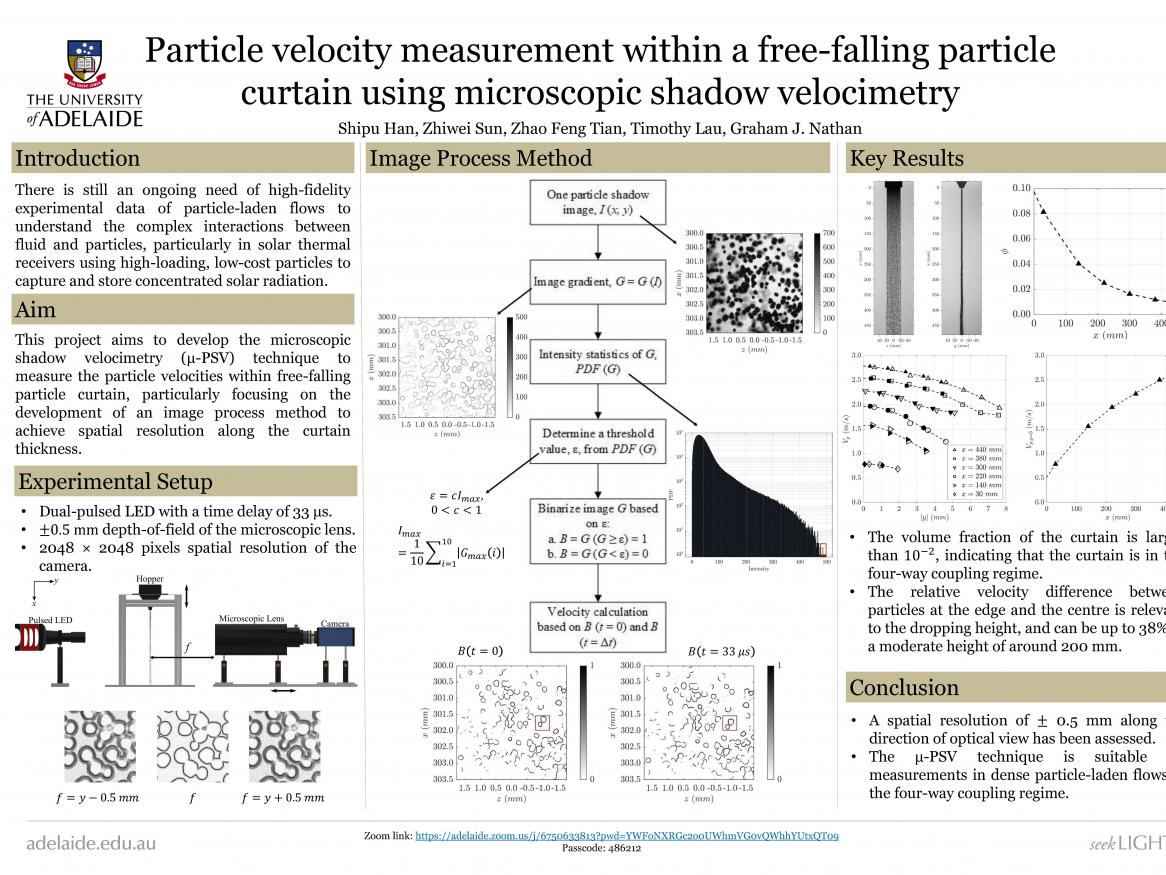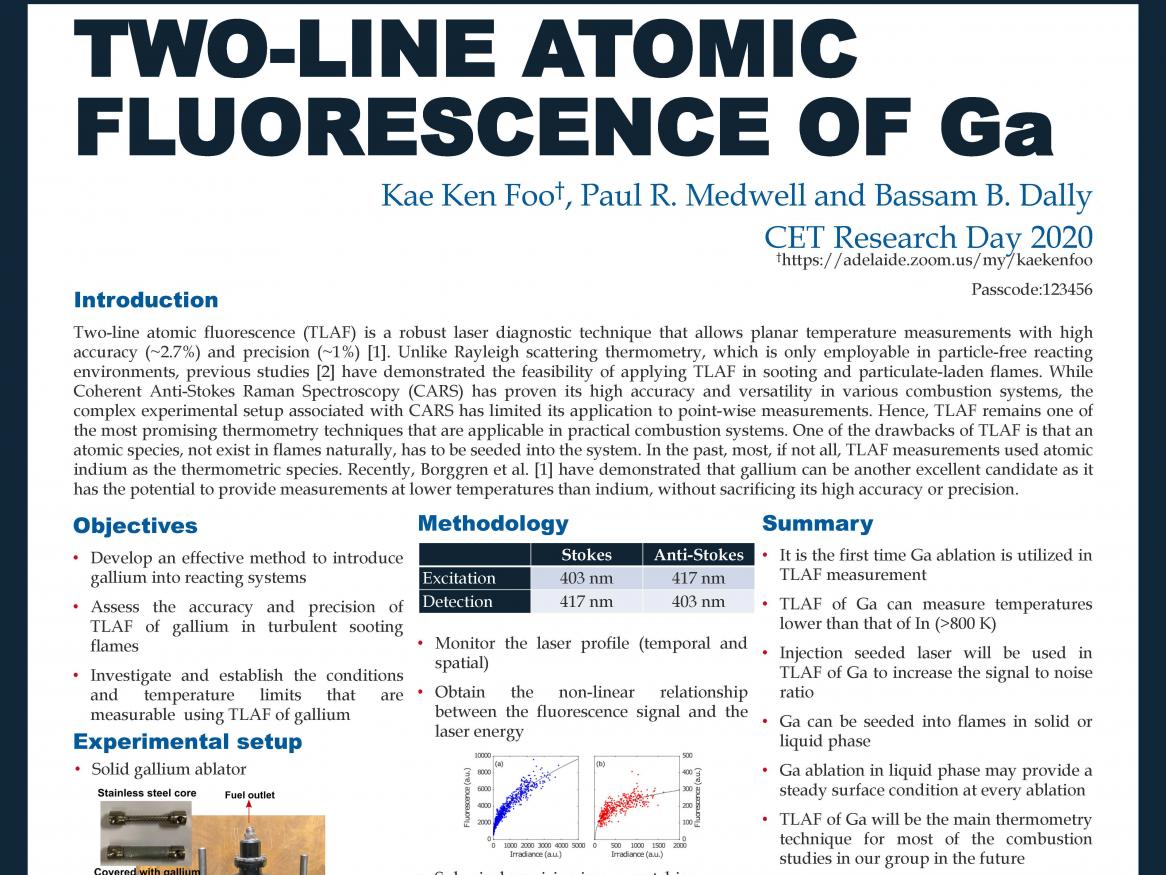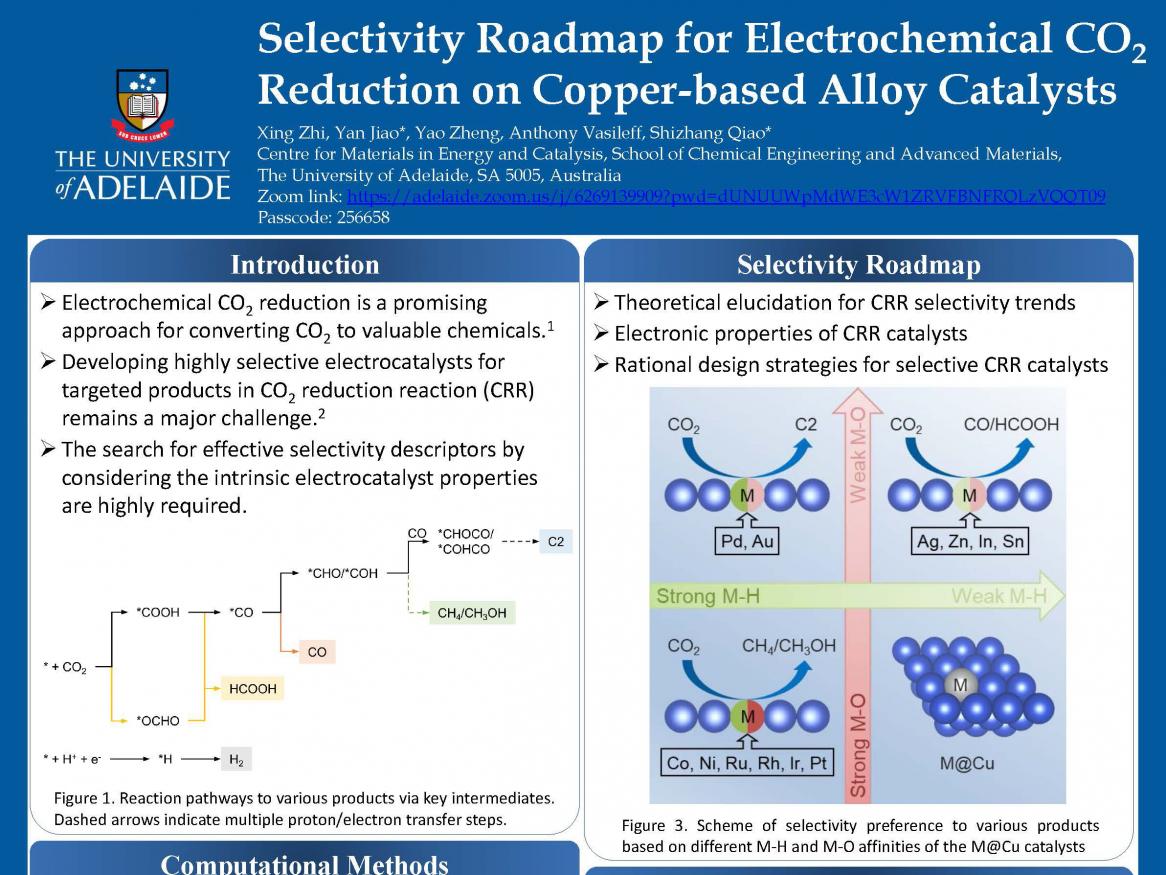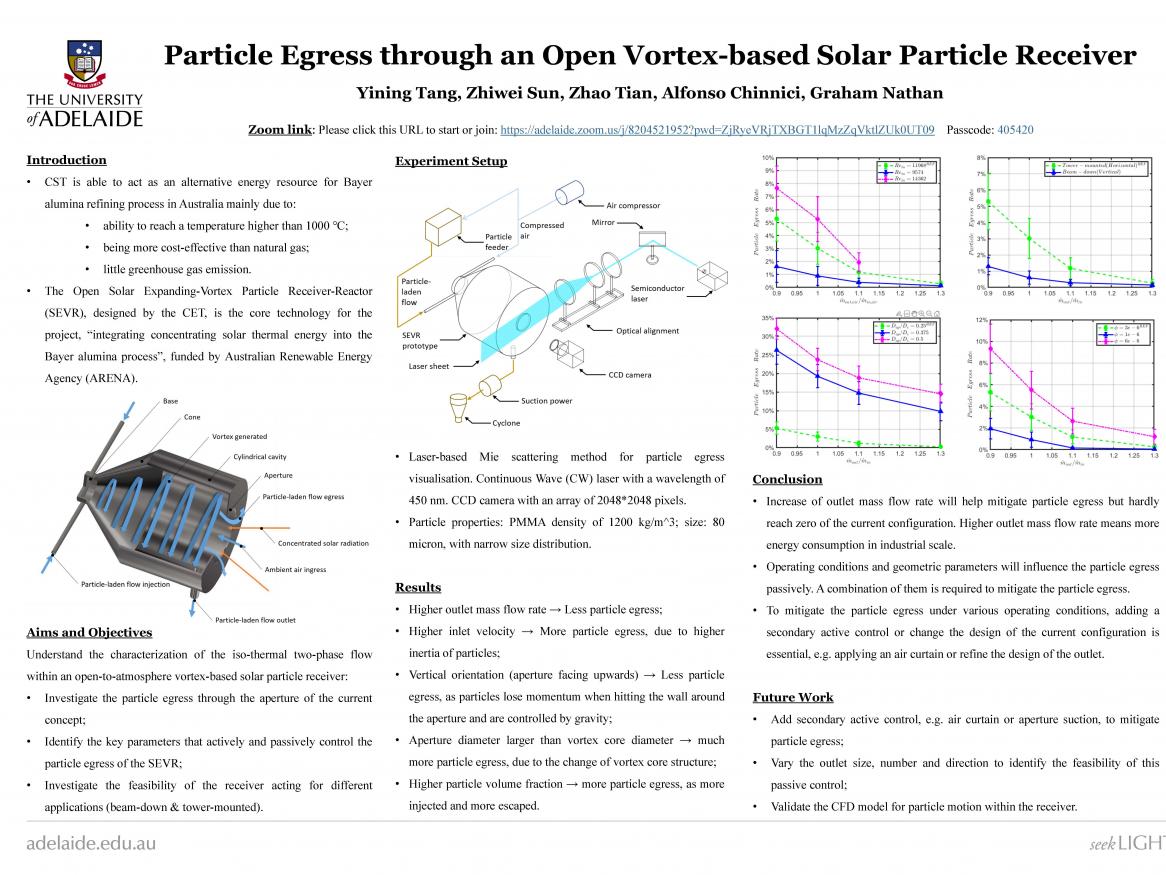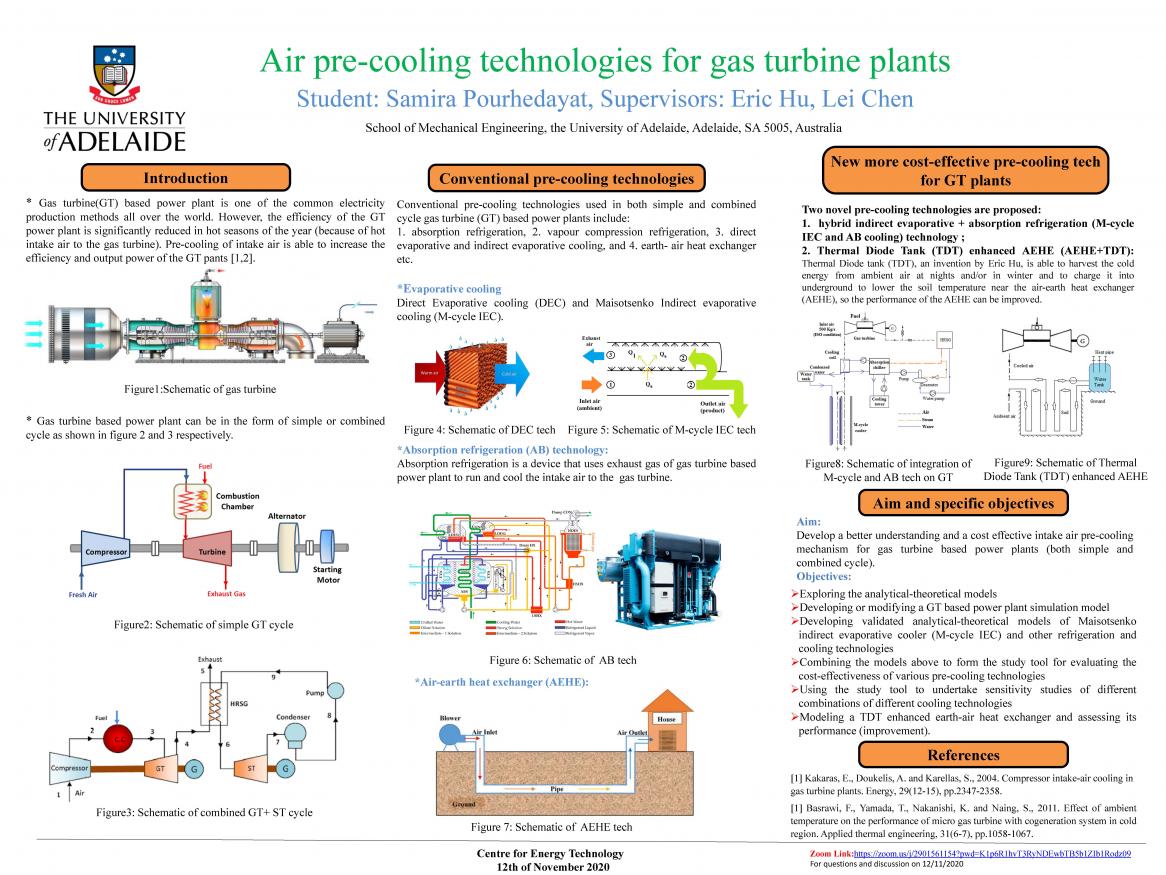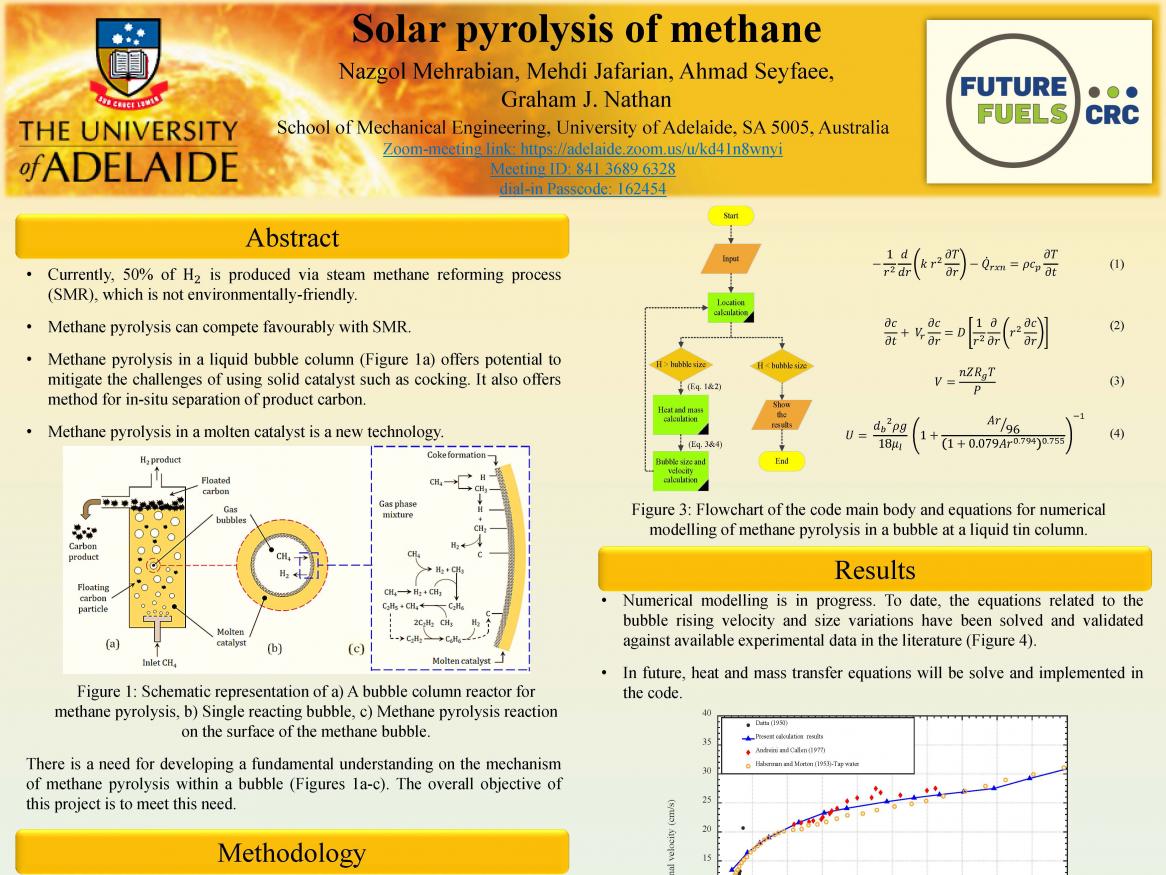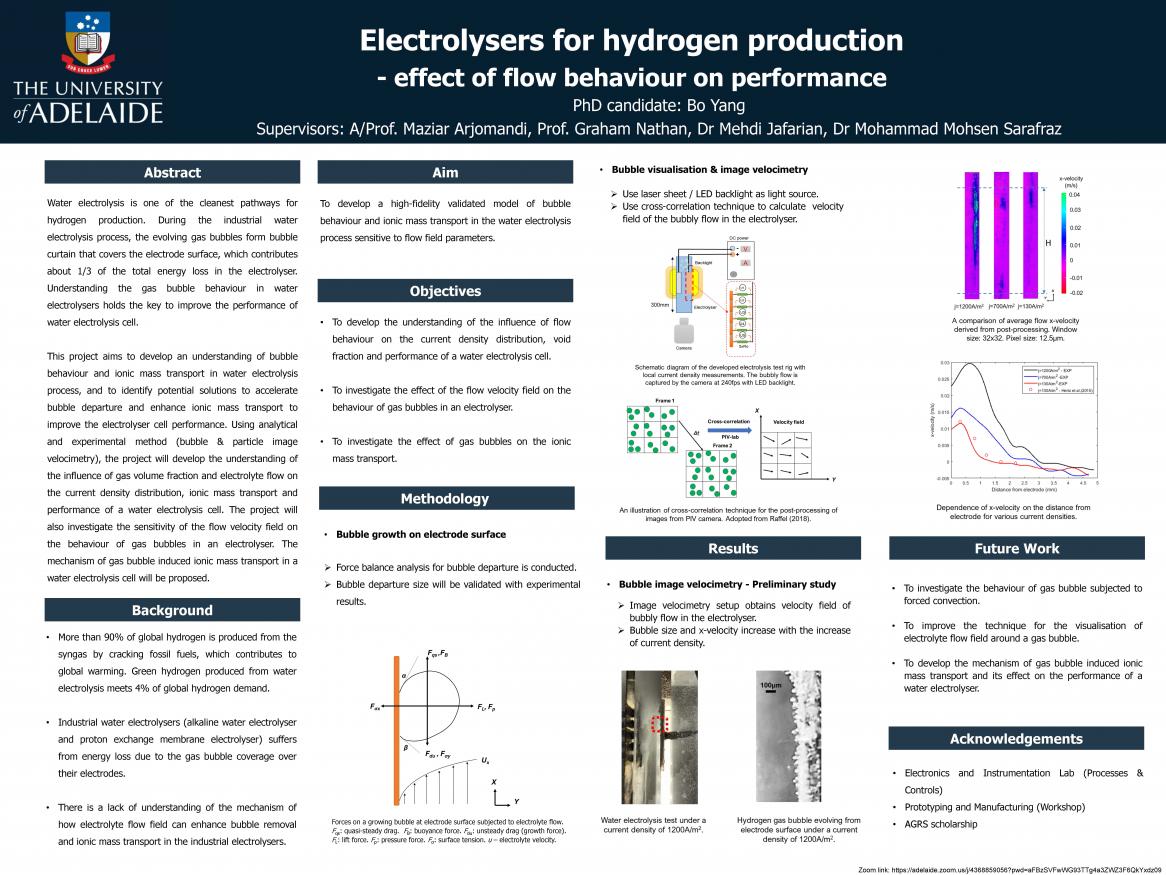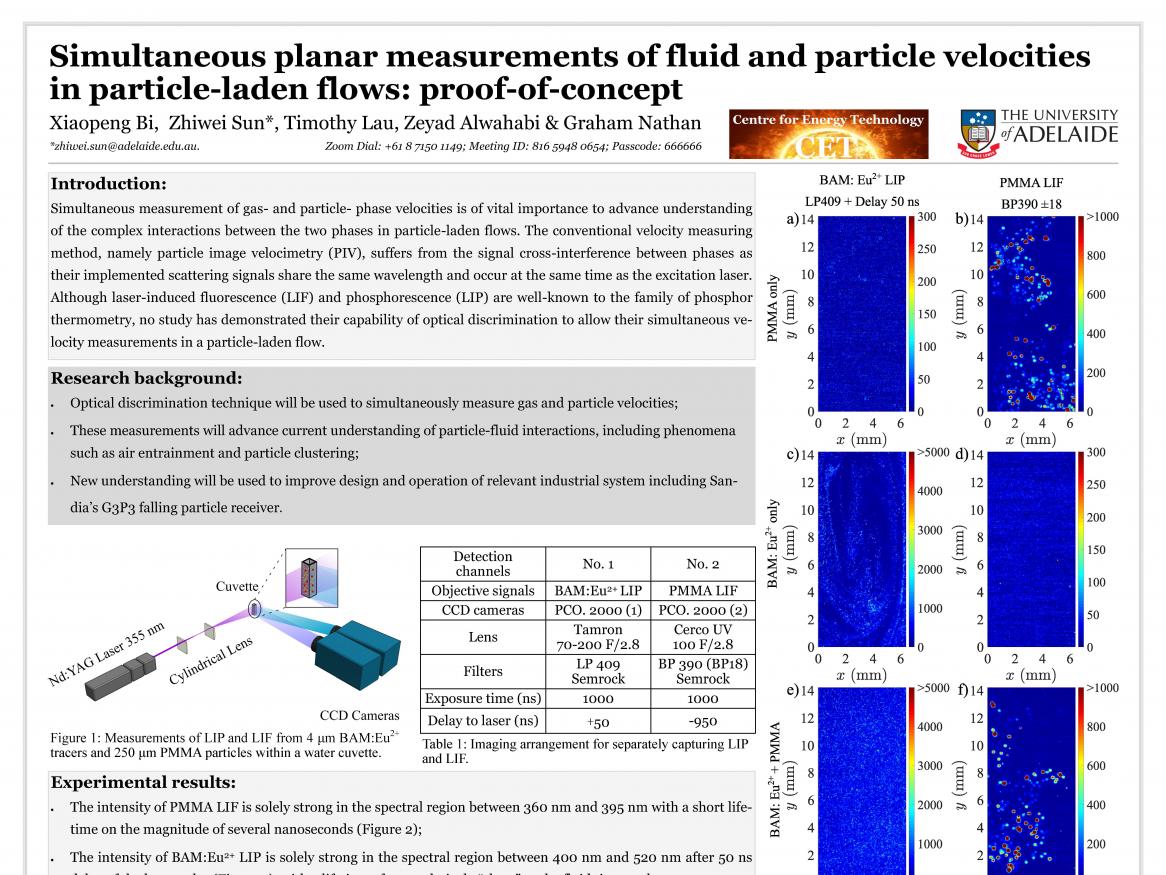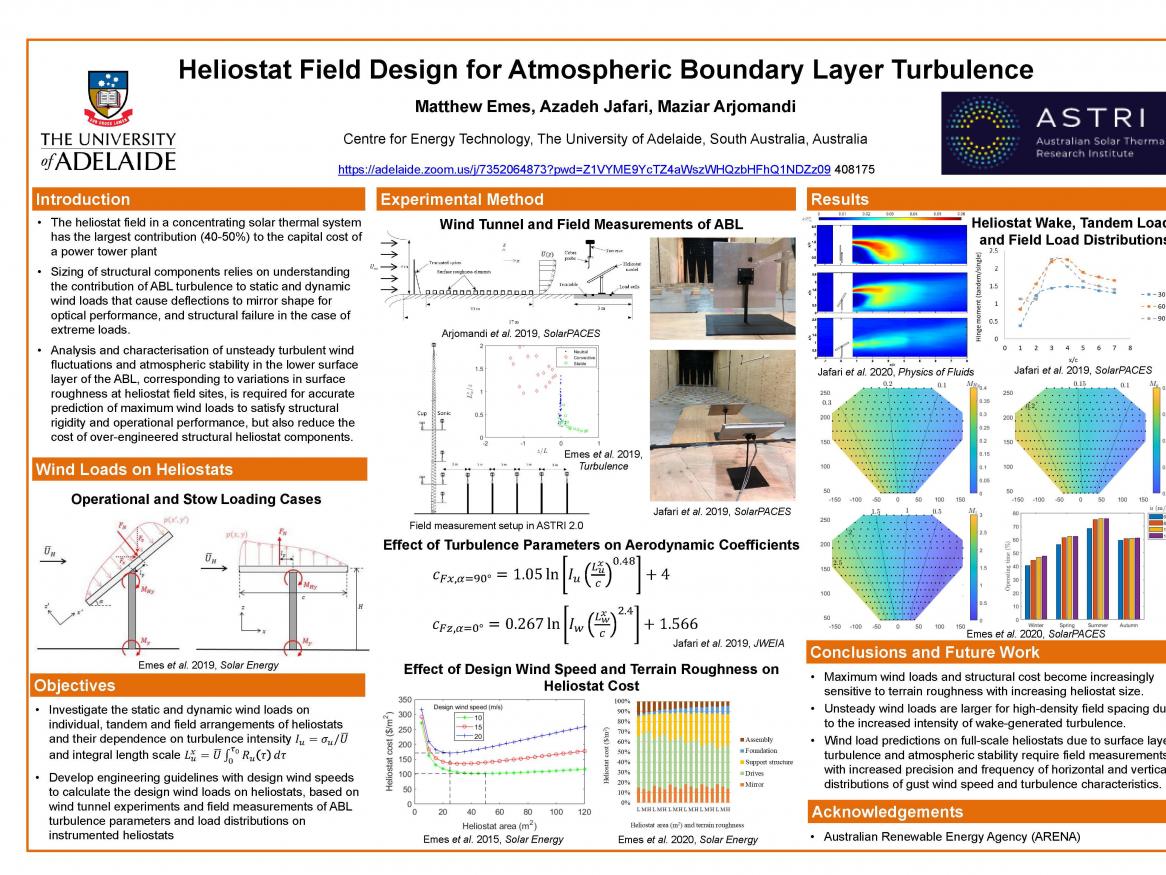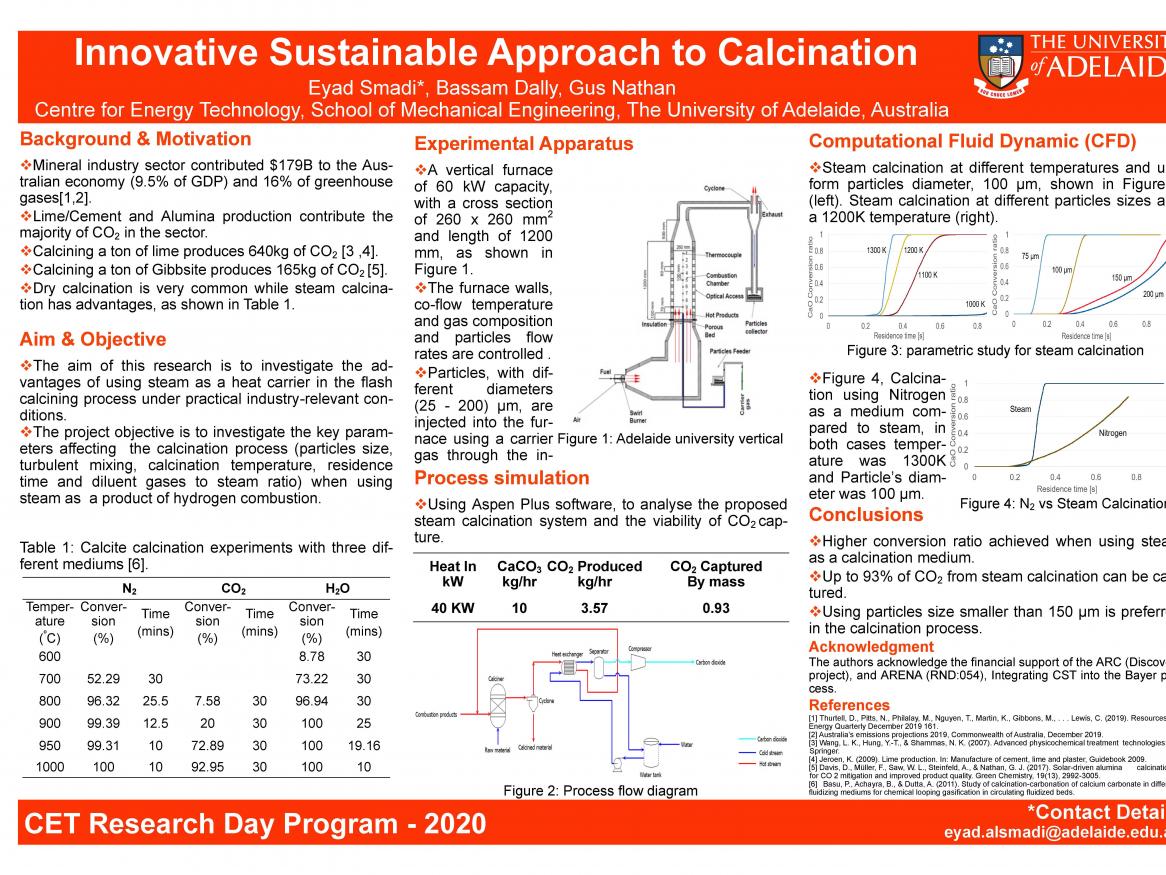CET Research Day Posters
A virtual poster session will be held from 12:00 - 12:30pm on Thursday 12 November, as part of CET Research Day.
Shipu Han
Particle velocity measurement within a free-falling particle curtain using microscopic shadow velocimetry
This project presents the development of the microscopic shadow velocimetry (μ-PSV) technique to measure the particle velocities within free-falling particle curtain, particularly focusing on the development of an image process method to achieve spatial resolution along the curtain thickness.
Zoom link: https://adelaide.zoom.us/j/6750633813?pwd= YWFoNXRGc2o0UWhmVG0vQWhhYUtxQT09
Passcode: 486212
Huanyu Jin
Single-crystal nitrogen-rich 2D Mo5N6 nanosheets for efficient and stable seawater splitting
Electrochemical seawater splitting provides a new avenue to low–cost and large–scale hydrogen production. However, commercial noble-metal based electrocatalysts exhibit poor performance under seawater conditions due to the poisoning effects from a range of undesirable anions. In this work, we synthesized two-dimensional (2D) nitrogen-rich Mo5N6 nanosheets with outstanding catalytic performance in natural seawater with a highly stable catalytic current over 100 h. This work demonstrated the possibility of cost-effective hydrogen production from seawater using 2D Mo5N6 nanosheets as the electrocatalyst.
Zoom link: https://adelaide.zoom.us/j/8906189929?pwd=Tnc0ampURG9kZlJBN3JYaWdWSnVGZz09
Passcode: 312392
Kae Ken Foo
Two-line atomic fluorescence of Ga
Previous studies have demonstrated that two-line atomic fluorescence (TLAF) of indium is capable of providing high accuracy and precision planar temperature measurements in sooting flames. However, one of the drawbacks of using indium is its lower temperature threshold (800 K). Using gallium as the thermometric species, instead of indium, can extend the temperature measurements to a lower limit. This study will be the first-time gallium is seeded using laser ablation for TLAF measurements.
Zoom link: https://adelaide.zoom.us/my/kaekenfoo
Passcode: 123456
Ling Chen
Copper nanopyramids promote C-C coupling and enable electroreduction CO2 to valuable C2+ chemicals
Converting CO2 to high value-added C2+ hydrocarbons by CO2 Reduction Reaction (CO2RR) attracted attention due to higher energy density, readiness for transportation and established utilization infrastructure. Modelled by Density Functional Theory (DFT) calculation, Cu nanopyramids with various orientations and shapes exhibit extraordinarily high C2 selectivity as a result of anomalous C-C coupling behavior on new type of C2 active sites, which can be predicted by our developed active site screening method-the extended ‘square’ principle. We also found that densely arrayed Cu nanopyramids can introduce confined space which serves as the avenue for the selective hydrogenation of intermediates, and consequently enables the direct electroreduction of CO2 to ethylene glycol. Our findings suggest a simple and effective approach for selective CO2 electroreduction to desirable C2+ products.
Zoom link: https://adelaide.zoom.us/j/86802692695?pwd=ZUJBcENNUUh3SnU4akpRRDUxU24rQT09
Sijia Fu
CO2 reduction by single copper atom supported on g-C3N4 with asymmetrical active sites
Electrochemical reduction of CO2 requires catalysts beyond Cu with high activity and selectivity to produce C2 products.
Our study provides reaction mechanism insights for C2 production on Cu-C3N4 and sheds light on designing electrocatalysts with dual active sites.
Zoom link: https://adelaide.zoom.us/j/81348424923?pwd=OUptZnNsZFRrTU5HbVVGc0xxNkpHdz09
Xing Zhi
Selectivity roadmap for electrochemical CO2 reduction on copper based alloy catalysts
Due to the complex reaction network of the electrochemical CO2 reduction reaction (CRR), developing highly selective electrocatalysts for desired products remains a major challenge. In this work, a novel descriptor-based approach to predict CRR selectivity of catalysts is developed. The selectivity based on intrinsic properties offers a rational design strategy for highly selective CRR electrocatalysts.
Zoom link: https://adelaide.zoom.us/j/6269139909?pwd=dUNUUWpMdWE3cW1ZRVFBNFRQLzVQQT09
Passcode: 256658
Yining Tang
Particle egress through an open vortex-based solar particle receiver
We develop an open-to-atmosphere vortex-based solar particle receiver and identify some controlling parameters that have effect on particle egress through the aperture.
Zoom link: https://adelaide.zoom.us/j/8204521952?pwd=ZjRyeVRjTXBGT1lqMzZqVktlZUk0UT09
Passcode: 405420
Samira Pourhedayat
Air pre-cooling technologies in industrial application
As the intake air temperature is a key factor on the performance and power output of gas turbine, the researchers enthusiastically work on different pre-cooling technologies for the intake air to enhance the performance of the gas turbine without the negative side effects (such as erosion and corrosion). This research aims to develop and assess an innovative intake air precooling technology for gas turbine-based power plants based on hybrid systems using analytical-theoretical approaches.
Zoom link: https://zoom.us/j/2901561154?pwd=K1p6R1hvT3RyNDEwbTB5b1ZIb1Rodz09
Nazgol Mehrabian
Solar pyrolysis of methane
Currently, 50% of H2 is produced via steam methane reforming process (SMR), which is not environmentally-friendly. Methane pyrolysis can compete favourably with SMR. Methane pyrolysis in a liquid bubble column offers potential to mitigate the challenges of using solid catalyst such as cocking. It also offers method for in-situ separation of product carbon. Methane pyrolysis in a molten catalyst is a new technology. There is a need to develop a fundamental understanding on the mechanism of methane pyrolysis within a bubble. The overall objective of this project is to meet this need.
Zoom link: https://adelaide.zoom.us/u/kd41n8wnyi | Meeting ID: 841 3689 6328 | dial-in Passcode: 162454
Matthew Xinchen Zhang
A numerical study of the effects of gravity on horizontal particle-laden pipe flows
This study presents numerical simulations of particle-laden flows in horizontal circular pipes to identify the key flow regimes as a function of key dimensionless parameters. A Euler-Lagrangian approach was employed, using direct numerical simulations (DNS) coupled with a Lagrangian particle tracking (LPT) method, to consider the drag, gravitational and lift forces on particles, as well as the effect of inter-particle collisions. The influence of the Stokes number, mass loading ratio and Froude number on critical flow regimes was assessed to identify conditions under which gravity bias becomes either negligible or dominant with regard to fluid characteristics and particle statistics. Three different patterns of the flow behaviour were identified, depending on various regimes of these dimensionless parameters. Also, three-dimensional regime maps of these regimes are reported, showing the influence of these three parameters on the degree of asymmetry of the flow behaviour, to advance understanding of horizontal particle-laden pipe flows.
Zoom link: https://adelaide.zoom.us/j/4282831194?pwd=dWxwNS9KRSsvSE9QSFNuaXpxMlVpUT09
Passcode: 998956
Bo Yang
Electrolysers for hydrogen production - effect of flow behaviour on performance
Gas bubble contributes to about 1/3 of total energy loss in the industrial water electrolysis cell. This project aims to develop an understanding of bubble behaviour and ionic mass transport in water electrolysis process, and to identify potential solutions to accelerate bubble departure and enhance ionic mass transport to improve the electrolyser cell performance.
Zoom link: https://adelaide.zoom.us/j/4368859056?pwd=aFBzSVFwWG93TTg4a3ZWZ3F6QkYxdz09
Yilong Yin
Adaptation of renewable fuel to high temperature industrial processes
This project aims to investigate the feasibility of using carbon-free fuel in the high-temperature industrial processes in order to achieve a significant reduction in greenhouse gas (GHG) emissions and meet the COP 21 commitment. Blending hydrogen with a small amount of highly sooting hydrocarbon dopants to enhance the radiant intensity of the hydrogen flames is one of the approaches focused in this project.
Zoom link: https://adelaide.zoom.us/j/5242016749?pwd=TVZUK0JrMmxRV094ZFJ2TUFnNlUydz09
Password: 524097
Elham Alipour
Design and development of a fluidic barrier for solar cavity receivers
The investigation of aerodynamic approaches to mitigate the convective heat transfer from tower mounted solar cavity receivers and provision of detailed insights into the mechanism that underpins each of these approaches is the aim of this project.
This aim was achieved by systematic combined experimental and numerical studies over a wide range of operating conditions relevant to actual application of solar cavity receivers. An electrically-heated scaled down model of solar cavity equipped with variation of air curtain configurations was used in a large wind tunnel with a verity of wind speeds.
The results provided useful insights into the effect of air curtain design and operating condition on the convective heat loss mitigation. This work provided the foundation for utilisation of aerodynamic active flow for real world application of solar cavity receivers to improve the thermal efficiency of solar tower plants.
Zoom link: https://adelaide.zoom.us/j/5247566737?pwd=N1R2RDljdll5cENhbUhhcXgwSEJaUT09
Passcode: 764186
Gavin Xiaopeng Bi
Simultaneous planar measurements of fluid and particle velocities in particle-laden flows: proof-of-concept
A promising optical method for separation of signals to allow their simultaneous PIV measurement of both fluid- and particle- phase velocities has been demonstrated with only using luminescent signals.
Zoom link: https://adelaide.zoom.us/j/81659480654?pwd=YnJDTXhULzJDQXBXRTMvYWhFM05QQT09
Matthew Emes
Heliostat field design for atmospheric boundary layer turbulence
Maximum wind loads and structural cost become increasingly sensitive to terrain roughness with increasing heliostat size. Unsteady wind loads are larger for high-density field spacing due to the increased intensity of wake-generated turbulence. Wind load predictions on full-scale heliostats due to surface layer turbulence and atmospheric stability require field measurements with increased precision and frequency of horizontal and vertical distributions of gust wind speed and turbulence characteristics.
Zoom link: https://adelaide.zoom.us/j/7352064873?pwd=Z1VYME9YcTZ4aWszWHQzbHFhQ1NDZz09
Daniel Ang
Global performance within a directly irradiated windowless vortex-based solar receiver
A novel windowless configuration of the Solar Expanding Vortex Receiver (SEVR) is proposed in heating particles for potential thermal applications such as particle heater, mineral-processing and steam-gasification. This systematic study aims to assess the influence of particle size, volumetric flow-rate and particle volumetric loading on the global performance in a windowless two-phase vortex based solar receiver. The experiment was conducted on a cavity receiver by injecting a steady vortex flow laden with particles within a cavity receiver which is exposed to concentrated solar radiation from the UA 18kW three-lamp solar simulator. The experimental parameters include the variation of flux input, particle size, mass loading and inlet flow speeds, which will be used to determine the first order controlling parameters on the thermal performance in the particle receiver. A numerical was also conducted using commercial CFD package, ANSYS CFX R1. The study also provides information through comparison of different inlet flow rates under different particle size to verify concepts of particle residence time conducted in previous studies of the receiver.
Zoom link: https://adelaide.zoom.us/j/81547171473?pwd=NHBESTNvZS9NQm1IQUtOeHJSTklTZz09
Passcode: 382203
Muhammad Mujahid Rafique
Mathematical modelling to assess the influence of transients on refractory-lined solar receivers
The aim of this project is to analyse and optimize the thermal performance of a refractory-lined particle receiver in response to solar resource variability. A transient heat transfer model for a particle-based solar receiver was developed. This model was employed to assess the time-dependent temperature fields of the receiver cavity walls, the particles, and gas from the initial state to another equilibrium based on the actual direct normal irradiance (DNI). The present research will help to investigate the start-up behaviour and overall thermal performance of the refractory-lined particle receivers for different processes based on available solar energy and load requirements.
Zoom link: https://adelaide.zoom.us/j/89970934255?pwd=SWFqWVl4RENYb0RidnNNbm5heGRMQT09
Eyad Smadi
Innovative Sustainable Approach to Calcination Process
This project aims to help transform the energy-intensive mineral industry to a low carbon future using sustainable fuel. While calcination process playing major role in mineral industry, the current research seeks to investigate the advantages of using steam as a heat carrier in the flash calcining process under practical industry-relevant conditions. In particular, the current research seeks to investigate the key parameters affecting the calcination process (particle size, turbulence, calcination temperature, residence time and diluent gases to steam ratio) when using steam as a product of hydrogen combustion.
Zoom link: https://adelaide.zoom.us/j/7535327720?pwd=cDdrcHdPVzhvekZLVmwwSzFTbWJ2UT09

